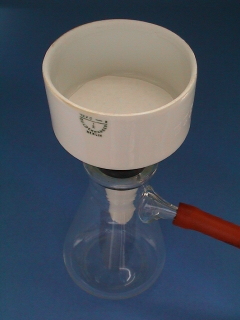- Büchner funnel
Infobox Laboratory equipment
name = Büchner funnel
caption = A Büchner funnel connected to a flask with a tube leading to avacuum pump
acronym =
other_names =
uses =Filtration
inventor =Ernst Büchner
manufacturer =
model =
related =Hirsch funnel Dropping funnel Separatory funnel A Büchner funnel is a piece oflaboratory equipment used insuction filtration . [cite journal |url=http://jchemed.chem.wisc.edu/hs/Journal/Issues/2006/Sep/clicSubscriber/V83N09/p1283.pdf |format=PDF |title=The Origins of the Hirsch and Büchner Vacuum Filtration Funnels |journal=Journal of Chemical Education |volume=83 |issue=9 |date=September 2006 |pages=1283 |last=Jensen |first=William B.] It is traditionally made ofporcelain , butglass andplastic funnels are also available. On top of the funnel-shaped part there is a cylinder with a perforated plate separating it from the funnel. The Hirsch funnel has a similar design; it is used similarly, but for smaller quantities of material. The main difference is that the plate is much smaller, while the walls of the funnel angle outward instead of being vertical.The filtration material, usually
filter paper , is placed on the plate, and the filter paper is moistened with a solvent to prevent initial leakage. Theliquid to be filtered is poured into the cylinder and drawn through the perforated plate byvacuum suction.The main advantage in using this type of filtration is that it proceeds much more quickly (several orders of magnitude) than simply allowing the solvent to drain through the filter medium via the force of gravity. It is essential that the amount of solvent being used be limited to less than what would overflow the flask, otherwise the solvent will be drawn into the vacuum equipment. If the vacuum is provided by a water flow device, an overflow of the solvent could result in the spilling of a hazardous solvent into the wastewater stream, a potential violation of the law, depending on the solvent. The potential for overflow and the potential for water to be drawn back into the flask can be reduced by using a trap between the flask and the vacuum source.
It is used in organic chemistry labs to assist in collecting recrystallized compounds. The suction allows the wet recrystallized compound to dry out such that the pure dried crystal compound is left remaining. Although, it is often the case that further drying is required, by an oven or other means, in order to remove as much residual solvent as possible.
It is often used in combination with a
Büchner flask .It is commonly thought to be named for the Nobel Laureate,
Eduard Buchner , but it is actually named for the industrial chemistErnst Büchner .References
Wikimedia Foundation. 2010.
